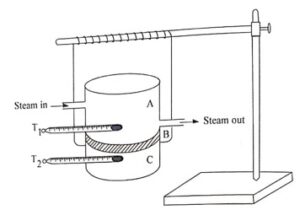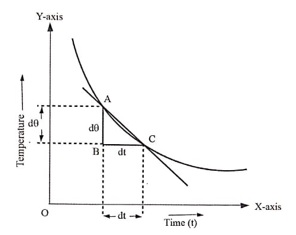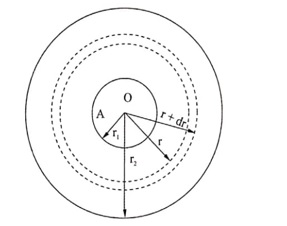The thermal conductivity of a material is determined by following methods
- Lee’s disc method – for bad conductors
- Radial flow method – for bad conductors
Lee’s Disc Method
Definition:
Lee’s disc method is an accurate method of measuring the thermal conductivity of poor conductor capable of giving results over a wide range of temperatures.
- The Lee’s disc apparatus consists of two thin discs A and C.
- The entire arrangements can be suspended from an iron stand.
- The specimen (bad conductor i.e., glass or card board) under test is taken in the form of a thin sheet B and placed between a copper disc C and a hollow cylinder A.
- The specimen has the same diameter as A or C. Holes are drilled near the bottom of A and the middle of C to take thermometer T1 and T2.
- These will indicate the temperatures of the faces of the specimen when the steady state is reached.
- The metal apparatus are chromium or nickel plated so that they will have the same emissive powers.

Working:
Now, the specimen is removed and the cylinders A and C are kept in contact, while steam is still passing through A until the temperature of the slab C rises by 8°C above the steady state temperature θ2. Now the upper cylinder A, is removed and C is exposed to the surrounding and allowed to cool. The temperature of the slab for every half a minute in recorded and a cooling curve is drawn as shown in (Fig. B). From this curve, the rate of cooling ![]() given by the slope of the cooling curve at the steady temperature of the slab C (i.e) θ2 is determined.
given by the slope of the cooling curve at the steady temperature of the slab C (i.e) θ2 is determined.

Now, the heat lost by radiation from the top and bottom and curved surface of the disc C is proportional to the area, 2πr2 + 2πrd.
Since![]() gives the rate of cooling, the rate of loss of heat is MS
gives the rate of cooling, the rate of loss of heat is MS ![]()
Where M is the mass of the disc C,
S is the specific heat.
In the first part of the experiment the total exposed surface area is (πr2+2πrd) and the heat radiated by this exposed area is given by
![]()
This quantity of heat must be equal to the quantity of heat conducted through the specimen during the steady state given by
![]()
Since they are equal,

Radial flow of heat
Definition:
Spherical shell method


![]()
Thus, the thermal conductivity K of the poor conductors can be calculated.
| Read More Topics |
| Classification of dielectric materials |
| Applications of superconducting materials |
| Classification of nonlinear materials |






